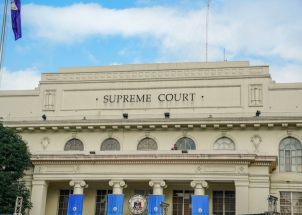Mayors join alliance to bring Laguna Lake back to life
December 22, 2002 | 12:00am
The Laguna Lake Development Authority (LLDA), an attached agency of DENR, hosted a press conference last Dec. 19, 2002 at the Pantalan ng Maynila Restaurant, Rizal Park. The event enabled the LLDA to present its milestones and accomplishments, and discuss with some members of the press (both print and broadcast), the environmental problems, issues and concerns besetting the Laguna de Ba’i and actions taken.
The discussions highlighted the initiatives and actions of LLDA that have brought significant improvements in the water quality and resources of the lake, and decline of pollution brought about by domestic wastes and a industries situated along the bay.
A panel headed by LLDA general manager Calixtio R. Cataquiz ably responded to queries and clarifications.
Organized by virtue of R.A. 4850, LLDA was initially tasked to "lead, promote and accelerate the development and balanced growth of the Laguna de Ba’i within the context of national and regional plans and policies for social and economic development." By virtue of P.D. 813 of 1975 and EO No. 927 of 1983. Its authority expanded to include environmental protection and jurisdiction over surface water of the lake and to carry out the development of the basin.
Laguna de Ba’i is one of he largest lakes in Southeast Asia and the largest and most vital inland body of water in the Philippines. It spans about 90,000 hectares, with approximately 100 streams draining into it. With an average depth of 2.5 meters. Facing the province of Laguna to the South, and the province of Rizal to the North. It is situated in the heart of CALABARZON. It serves nearly six million inhabitants and hosts some 3,000 enterprises.
The development of Laguna de Ba’i is vital to ecological conservation and economic growth. Currently, the lake’s most dominant use is for fishery. Considering that a great majority of Filipinos depend on lake and marine resources, its development is essential. Laguna de Ba’i has varied uses and advantages. It serves as navigational routes for lake travelers and users, provides power geneation (four power plants are located in the region), offers recreational activities, provides domestic water supply, serves as reservoir for floodwater, irrigation and industrial cooling.
The Polder Island Development Plan (PIDP) is the latest development initiative in the Lake. The city governments of Muntinlupa and Taguig and the municipal governments of San Pedro and Biñan, Laguna, have formalized their alliance to realize the PIDP.
For this purpose, Cataquiz, Mun. Mayor Jaime R. Fresnidi, Taguig Mayor Sigfrido R. Tinga, San Pedro Mayor Felicisimo A. Vierneza and Biñan Mayor Hermis C. Perez signed a memorandum of understanding to work cooperatively towards the implementation of the project that will ensure the sustainable development of the lake and water supply for the Metro Manila and nearby provinces in the coming years.
The PIDP involves the construction of four polder islands, spanning a total land area of 3,000 hectares, at the west side of Laguna de Ba’i. The island will be situated offshore, adjacent to the political jurisdiction of the four mayors. The southern-most island was designed to be an 800-hectare reservoir that will source, treat and distribute a minimum of 400 million liters of water per day from lake. It is foreseen to counter the water crisis that is projected to hit Metro Manila by 2006.
The discussions highlighted the initiatives and actions of LLDA that have brought significant improvements in the water quality and resources of the lake, and decline of pollution brought about by domestic wastes and a industries situated along the bay.
A panel headed by LLDA general manager Calixtio R. Cataquiz ably responded to queries and clarifications.
Organized by virtue of R.A. 4850, LLDA was initially tasked to "lead, promote and accelerate the development and balanced growth of the Laguna de Ba’i within the context of national and regional plans and policies for social and economic development." By virtue of P.D. 813 of 1975 and EO No. 927 of 1983. Its authority expanded to include environmental protection and jurisdiction over surface water of the lake and to carry out the development of the basin.
Laguna de Ba’i is one of he largest lakes in Southeast Asia and the largest and most vital inland body of water in the Philippines. It spans about 90,000 hectares, with approximately 100 streams draining into it. With an average depth of 2.5 meters. Facing the province of Laguna to the South, and the province of Rizal to the North. It is situated in the heart of CALABARZON. It serves nearly six million inhabitants and hosts some 3,000 enterprises.
The development of Laguna de Ba’i is vital to ecological conservation and economic growth. Currently, the lake’s most dominant use is for fishery. Considering that a great majority of Filipinos depend on lake and marine resources, its development is essential. Laguna de Ba’i has varied uses and advantages. It serves as navigational routes for lake travelers and users, provides power geneation (four power plants are located in the region), offers recreational activities, provides domestic water supply, serves as reservoir for floodwater, irrigation and industrial cooling.
The Polder Island Development Plan (PIDP) is the latest development initiative in the Lake. The city governments of Muntinlupa and Taguig and the municipal governments of San Pedro and Biñan, Laguna, have formalized their alliance to realize the PIDP.
For this purpose, Cataquiz, Mun. Mayor Jaime R. Fresnidi, Taguig Mayor Sigfrido R. Tinga, San Pedro Mayor Felicisimo A. Vierneza and Biñan Mayor Hermis C. Perez signed a memorandum of understanding to work cooperatively towards the implementation of the project that will ensure the sustainable development of the lake and water supply for the Metro Manila and nearby provinces in the coming years.
The PIDP involves the construction of four polder islands, spanning a total land area of 3,000 hectares, at the west side of Laguna de Ba’i. The island will be situated offshore, adjacent to the political jurisdiction of the four mayors. The southern-most island was designed to be an 800-hectare reservoir that will source, treat and distribute a minimum of 400 million liters of water per day from lake. It is foreseen to counter the water crisis that is projected to hit Metro Manila by 2006.
BrandSpace Articles
<
>
- Latest
Latest
Latest
May 14, 2024 - 3:43pm
By Ian Laqui | May 14, 2024 - 3:43pm
April 10, 2024 - 5:12pm
By Ian Laqui | April 10, 2024 - 5:12pm
March 4, 2024 - 3:32pm
By Ian Laqui | March 4, 2024 - 3:32pm
March 4, 2024 - 2:12pm
By Kristine Daguno-Bersamina | March 4, 2024 - 2:12pm
February 17, 2024 - 2:31pm
February 17, 2024 - 2:31pm
Recommended



























